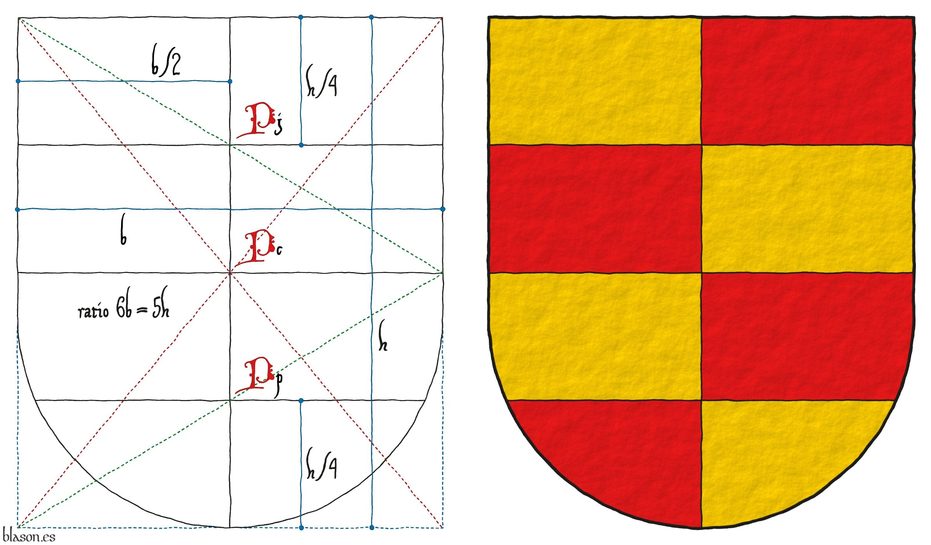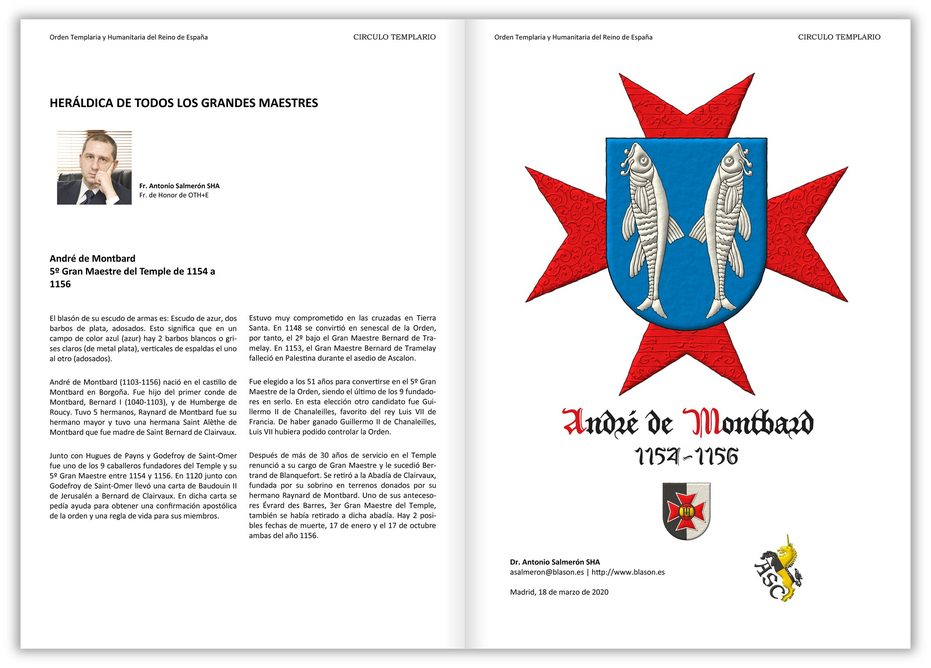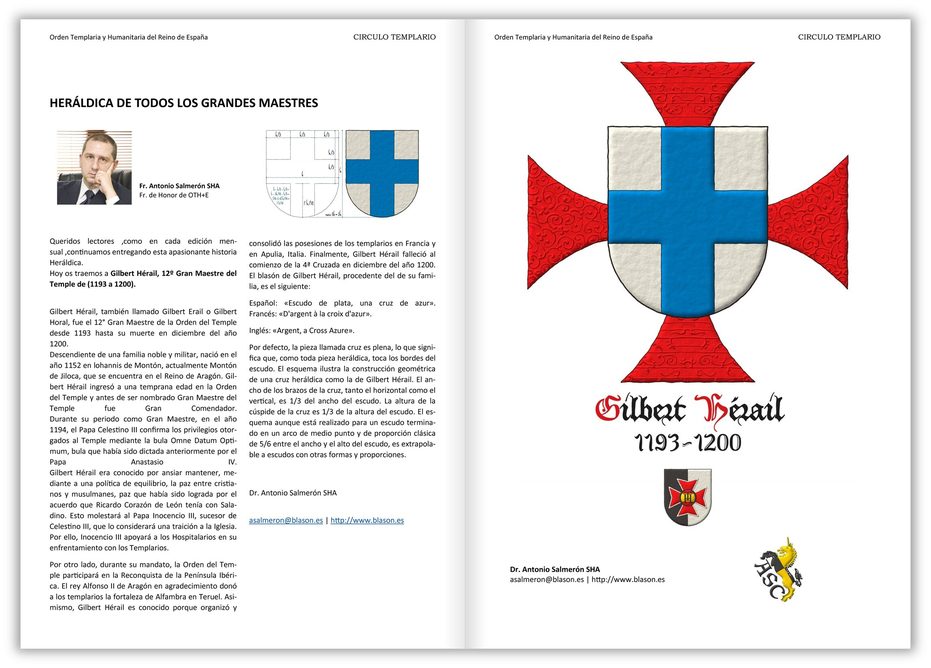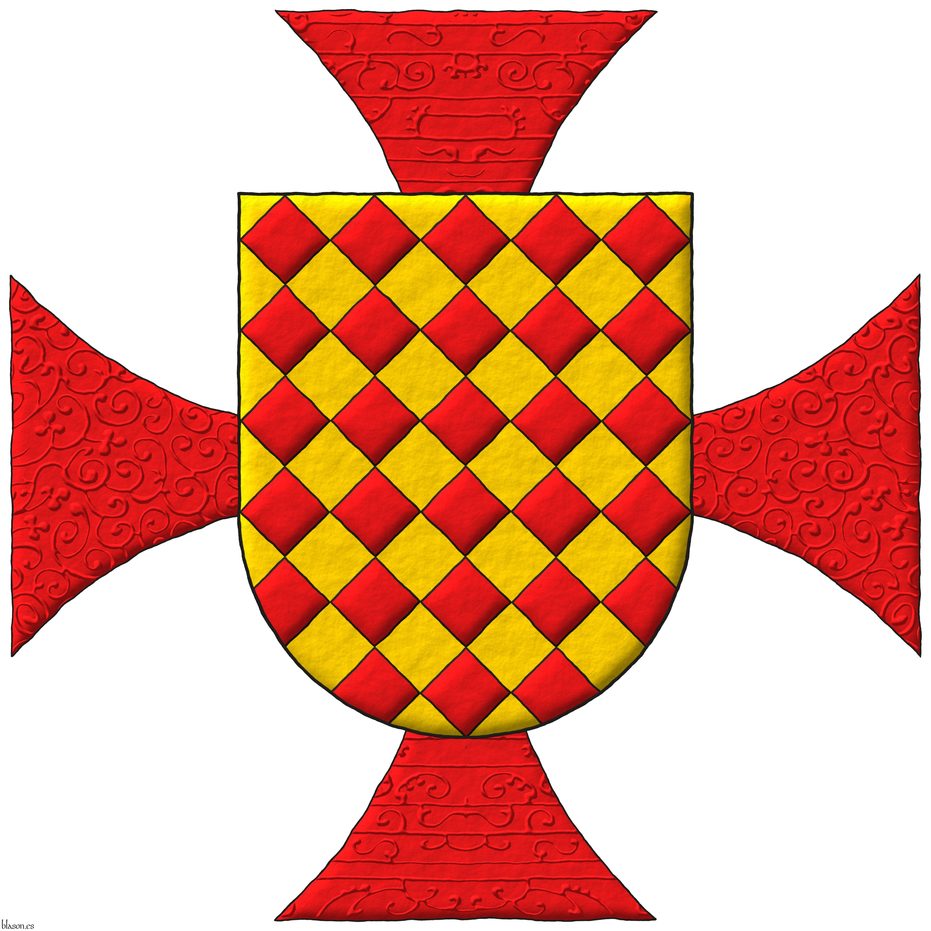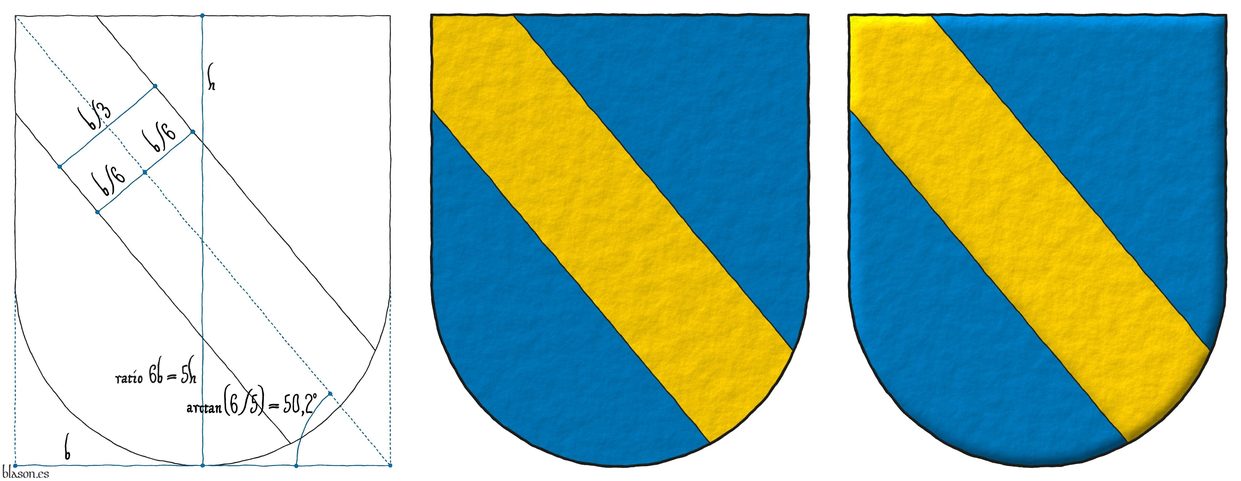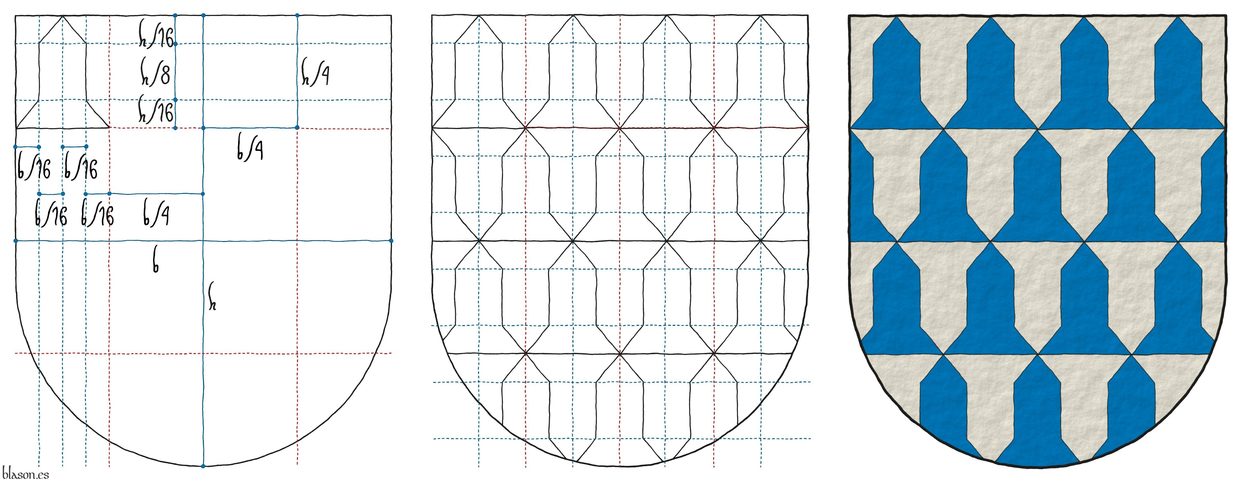Military heraldry

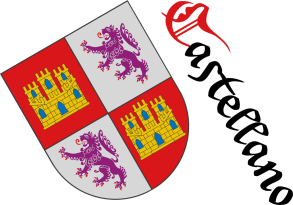
![Ver [Alcantara, Order of] en instituciones citadas. Fortaleza de oro y mazonada de sable.](../css/Fortaleza.Institucion.png)
Alcantara, Order of

It was founded by Count Henry of Burgundy as a military and religious order, in the year 1093, in Beira Alta, Portugal, near the river Côa with the initial name of «Ordem de São Julião do Pereiro» ~ Order of Saint Julian of Pereiro.
In the year 1214, the defense of the city of Alcantara after its conquest was entrusted to the Order of Calatrava, but in 1218 the Calatravans relinquished it due to Alcantara being far from Calatrava.
To defend Alcantara, King Alfonso IX of León entrusted it to the new Order of the Knights of Saint Julian of Pereiro, requesting in return a certain level of dependency on the Order of Calatrava, which led the Knights of Saint Julian to adopt the Cistercian rule.
Once established in Alcantara, their original name referring to Saint Julian fell into disuse, and by 1253 there were already references to the «masters of the Order of Alcantara», with Saint Julian of Pereiro becoming the foundational center and a secondary commandery of the order.
On the origin and antiquity of the Military Order of Alcantara, and the form of its Commandery
[Avilés, J.; 1780b; treatise IV, chapter V, page 339] describes it as follows: «The Military Order, which we now call of Alcantara, was formerly that of Saint Julian of Pereiro, so named after the place where it was based, along the banks of the river Côa, in the Bishopric of Ciudad-Rodrigo, established in the year 1176 by King Ferdinand II of León, and confirmed in 1177 by Pope Alexander III. And the reason for changing its first name to the second, was because after the Knights of Calatrava had taken the City of Alcantara from the Moors and defended it bravely thereafter, they found it would be difficult to keep it, as their main house was very distant, from which the other Knights and reinforcements could not come whenever needed.».
[Avilés, J.; 1780b; treatise IV, chapter V, page 340] continues by telling us «They discussed this inconvenience with others they had at the time with the King of León, Don Alfonso IX, and it was resolved that the Master of Calatrava would give that town to the Knights of Pereiro so that they might defend it, as they did, under certain conditions in the year 1218, later performing marvels in its defense, earning through their fame and distinguished feats new graces from the Kings; and seeing how essential their residence was, the Knights of Pereiro moved to the town of Alcantara, establishing their Convent there, and thus transformed into Knights of Alcantara, who were previously Knights of Saint Julian of Pereiro».
Categories: Institution, Interpreted, Religious, Military, Illuminated, Outlined in sable, Freehand, Emblem, Cross of Alcantara, Cross couped and Cross.


Artillery Combat School of the Swedish Army
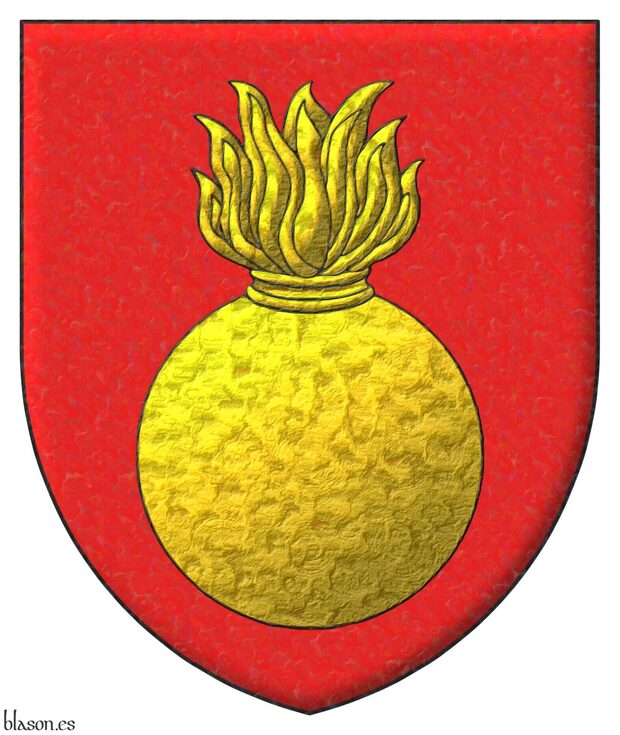
Kingdom of Sweden.
Gules, a grenade Or.
Escudo de gules, una bomba de oro.
Illuminated with lights and shadows and with a iridescent and metallic finish.
Blazon keywords: Without divisions, Gules, One, Grenade and Or.
Style keywords: Metal beaten, Iridescent (nacar), Outlined in sable, Illuminated and Pointed.
Classification: Interpreted, Military and Kingdom of Sweden.
Bearer: Artillery Combat School of the Swedish Army.


Bernard de Tremelay plain tincture
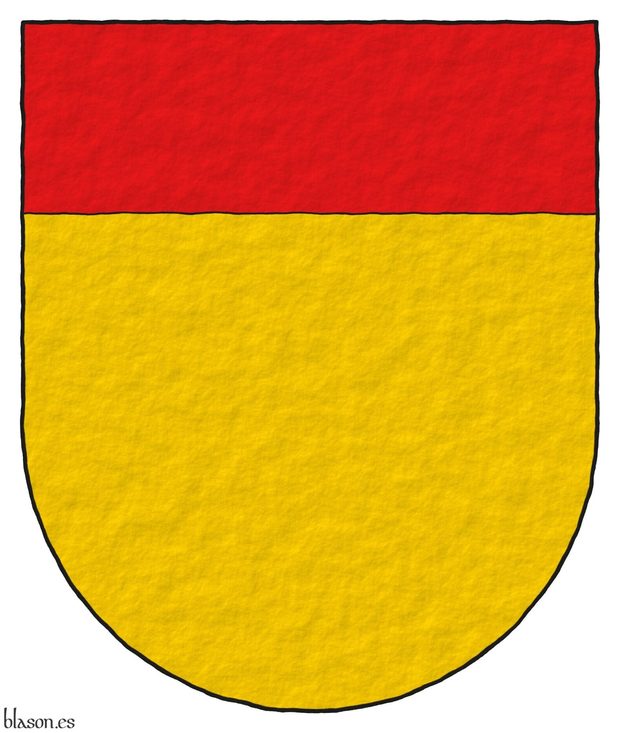
Or, a chief Gules.
Escudo de oro, un jefe de gules.
Blazon keywords: Or, Chief and Gules.
Style keywords: Outlined in sable, Semi-circular and Plain tincture.
Classification: Religious, Military, Knights Templar, Interpreted and Coat of arms.
Bearer: Tremelay, Bernard de.


Bertrand de Blanchefort two-step scheme
Barry of four per pale counterchanged Or and Gules.
Blazon keywords: Barry per pale counterchanged, Four, Or and Gules.
Style keywords: Outlined in sable, Semi-circular, Ratio and Plain tincture.
Classification: Religious, Military, Knights Templar, Interpreted, Coat of arms and Schema.
Bearer: Blanchefort, Bertrand de.


BPAC II, su cálculo de las barras
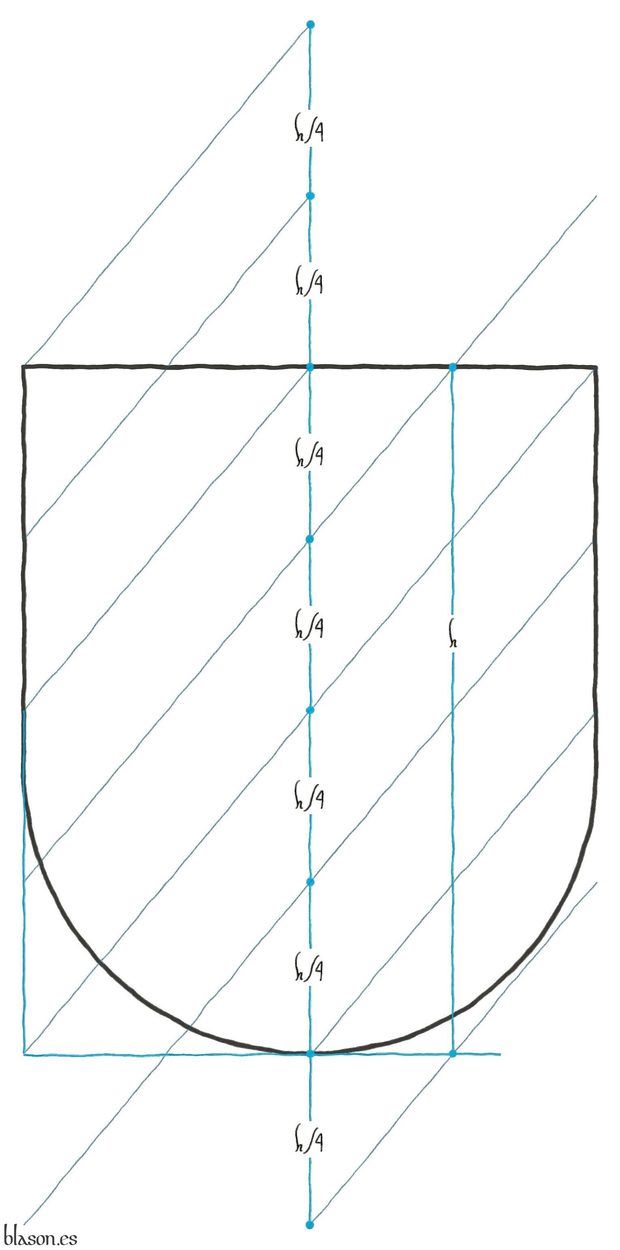
My approach to the method of drawing the bends used by the Spanish Army for the BPAC II coat of arms
Bendy sinister of seven.
Escudo, tres barras.
Note that if the classic width were used for the bends, which is 1/3 of the shield's width, then the bends would cover almost the entire field.
The vertical axis of symmetry has been extended above the chief and below the base, and has been divided into segments of 1/4 of the shield's height, «h» in the diagram that illustrates this article. At the ends of these segments, parallel lines have been drawn to the bend sinister diagonal of the shield. Since the shield has a 5x6 proportion, the angle of inclination of these diagonals is 50.2o..
Blazon keywords: Without divisions and Bend sinister.
Style keywords: Semi-circular and Freehand.
Classification: Schema and Military.
Bearer: BPAC II.


BPAC, Roger de Flor II
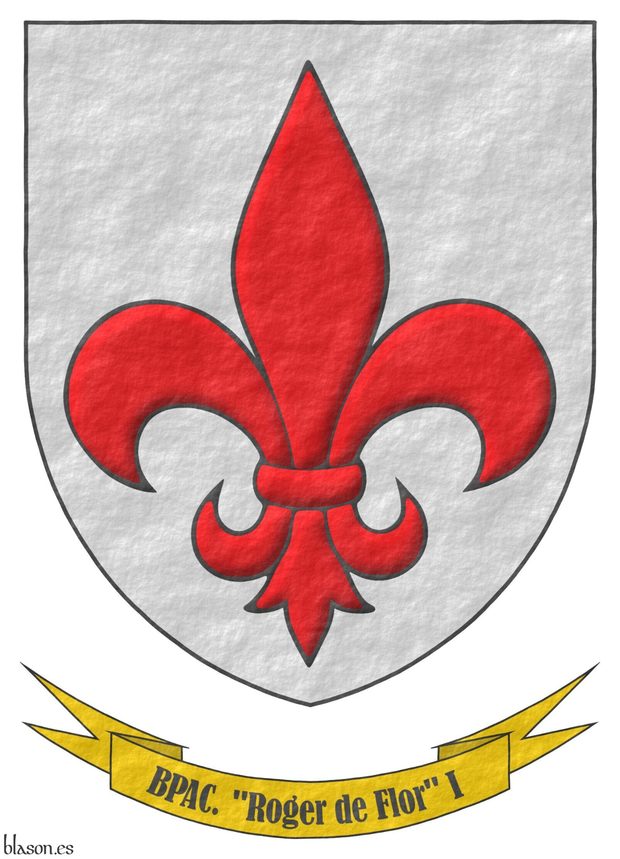
Light Parachute Infantry Unit.
Argent, a Fleur de lis Gules. Motto: «BPAC. Roger de Flor II».
Escudo de plata, una flor de lis de gules. Divisa: «BPAC. Roger de Flor II».
Coat of arms interpreted with: a shield with a pointed (ogival) base; a fleur de lis outlined in Sable and illuminated in Gules; and an overall rough finish.
Blazon keywords: Without divisions, Argent, Gules, Fleur de lis and Motto (identification).
Style keywords: Semi-circular, Illuminated, Outlined in sable and Rough.
Classification: Interpreted, Military, Army and Navy and Coat of arms.
Bearer: BPAC I.


Cavalry Regiment Alcantara, royal crown
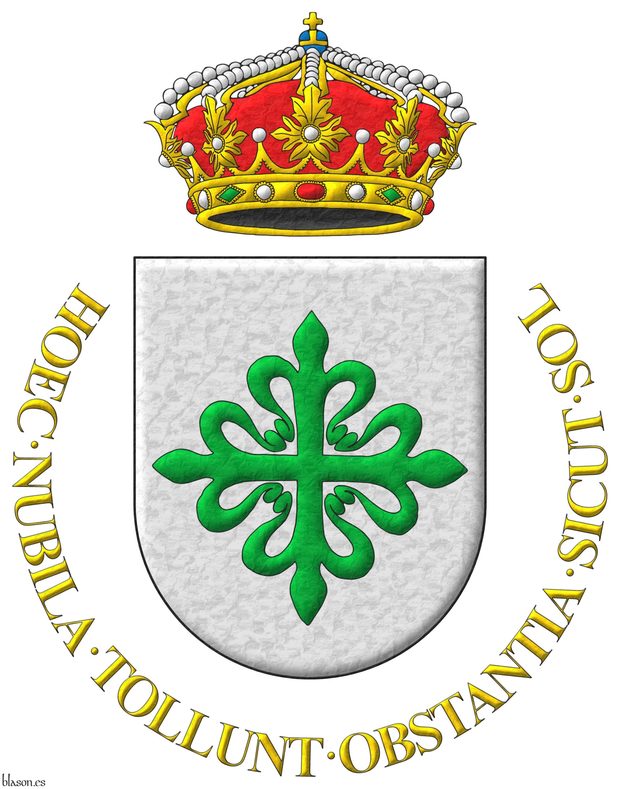
Disperse like the sun clears the clouds in your path.
Argent, a cross of Alcantara. Crest: A closed royal crown Or, with eight arches, visible five. Motto: «Hoec nubila tollunt obstantia sicut sol».
Escudo de plata, una cruz de Alcántara. Timbrado de una corona real cerrada. Lema: «Hoec nubila tollunt obstantia sicut sol».
Coat of arms interpreted in the following manner: the shape of the shield is of a semicircular arch; the field is illuminated in metal Argent; the cross of Alcantara is outlined in Sable and illuminated in Vert; the royal crown is closed, outlined in Sable and illuminated with the metal Or, Argent for the pearls, Azure and Or for the orb, Gules and Vert for the gems, Gules for the inner cloth, and Sable for the visible hollow at its base; and the whole has a slightly hammered metal finish.
Regiment's Motto
The Latin motto «Hoec nubila tollunt obstantia sicut sol» is often translated as «Ride like the sun, disperses the clouds in its path». I would like to offer the following observations on this translation:
- Instead of «disperse», I prefer the verb «scatter» which is more aligned with a cavalry regiment, [Royal Spanish Academy; 2001] «scatter, 3rd meaning, transitive verb, military term: To break up, rout the enemy, causing them to flee and scatter in complete disorder».
- On the other hand, even though it is about cavalry, I do not find that the Latin motto makes reference to riding, a verb that is also not needed to understand the motto's meaning, and adding an extra word lengthens the motto, reducing its impact.
- Finally, I use «your», instead of «its», so that the motto is a direct and personal rallying cry and not a phrase directed at a third person.
Blazon keywords: Without divisions, Argent, Cross of Alcantara, Cross couped, Cross, Crest, Closed royal crown, Crown and Motto.
Style keywords: Semi-circular, Illuminated, Outlined in sable and Soft metal.
Classification: Interpreted, Military, Army and Navy and Coat of arms.
Bearer: Alcantara, Cavalry Regiment.


Central Military Region
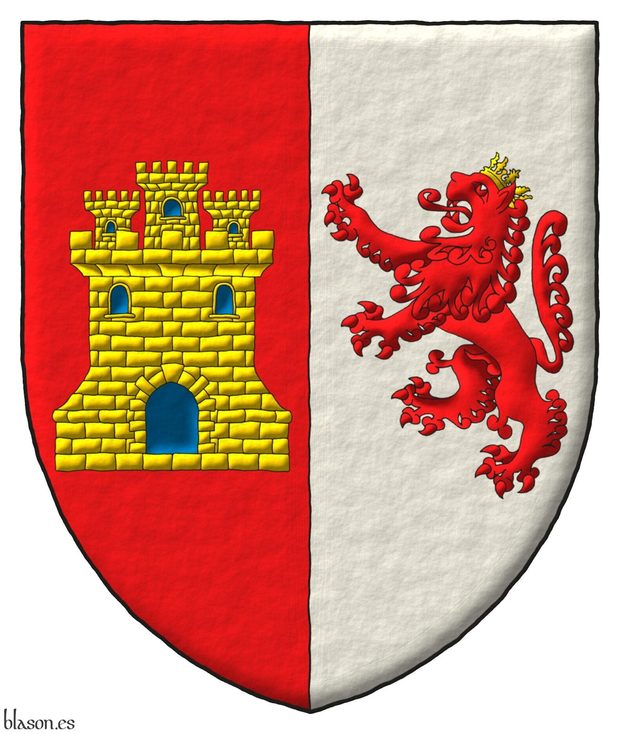
Party per pale: 1 Gules, a castle triple-towered Or, port and windows Azure, and masoned Sable; 2 Argent, a lion rampant Gules, crowned Or.
Coat of arms (1984-1997 and 1997-2002) of the former Central Military Region, where I serve. I interpreted now this coat of arms with a pointed shape. This kind of shape for this coat of arms are not usual.
Blazon keywords: Party per pale, Gules, One, Castle, Or, Port and windows, Azure, Masoned, Sable, Argent, Lion, Rampant and Crowned.
Style keywords: Pointed, Illuminated, Outlined in sable and Metal beaten.
Classification: Interpreted, Military, Army and Navy, Coat of arms and Kingdom of Castile and Leon.
Bearer: Central Military Region.


Crepsi
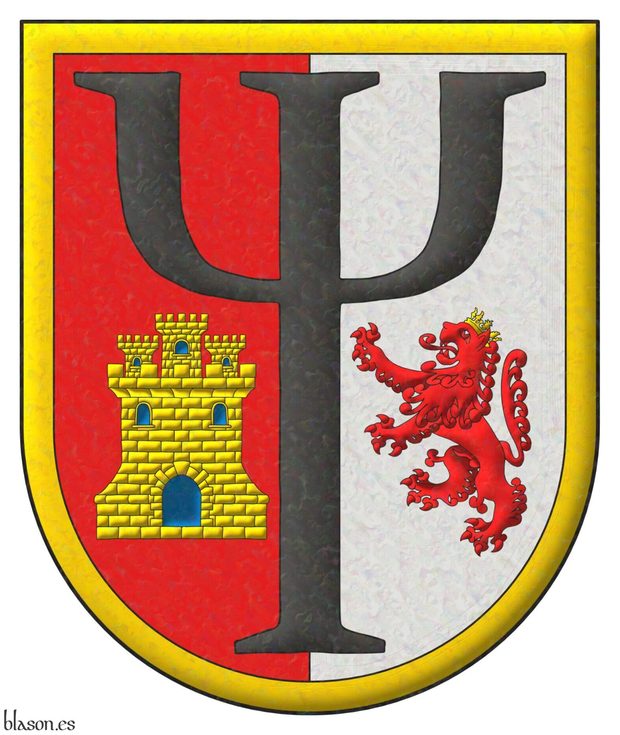
Party per pale: 1 Gules, in base a castle triple-towered Or, port and windows Azure, and masoned Sable; 2 Argent, in base a lion rampant Gules, crowned Or; overall a psi letter sable; a diminished bordure Or.
Escudo partido: 1o de gules, en punta un castillo de oro, aclarado de azur y mazonado de sable; 2o de plata, en punta un león rampante de gules, coronado de oro; brochante sobre la partición una letra psi de gules; una filiera de oro.
Coat of arms emblazoned by me, illuminated with lights and shadows, outlined in Sable, with a semi-circular outer contour and with a iridescent finishing.
Coat of arms of Crepsi, military psychology, former Central Military Region, Kingdom of Spain, where I was stationed during my military service. These arms were designed by my lieutenant colonel and friend Miguel Angel Nuñez Amador, and in this image, they have been emblazoned by me. The Crepsi was a pioneer in its functions: a) the identification of soldiers at psychological risk, among tens of thousands of soldiers, using advanced information systems, including Artificial Intelligence (an area where I contributed during my service in 1989), and b) the evaluation and individualized attention of soldiers at risk through mobile units. The Crepsi has provided trained personnel and methods that are being used for the psychological care of troops deployed to conflict zones and for the psychological care of civilians in massive humanitarian disasters such as terrorist attacks or plane crashes with hundreds of affected people.
Design rationale
The psi letter of psychology and the arms of the Central Military Region: Party per pale: 1 Gules, a castle triple-towered Or, port and windows Azure, and masoned Sable; 2 Argent, a lion rampant Gules, crowned Or. These two fields, in turn, Gules and Argent, charged with a castle triple-towered and a crowned lion, originate from the Kingdom of Castile and León. The diminished bordure is for difference.
Blazon keywords: Gules, Argent, Or, Azure, Sable, Party per pale, In base, Castle, Triple-towered, Port and windows, Masoned, Lion, Rampant, Crowned, Overall, Letter and Diminished bordure.
Style keywords: Outlined in sable, Illuminated, Semi-circular and Iridescent.
Classification: Military, Interpreted, Design rationale, Boa and Coat of arms.
Bearer: Crepsi.


Knights Templar, Grand Master number 05
Azure, two barbels addorsed Argent. Behind the shield an eight-pointed cross patty Gules.
I have had the honour of writing this article about André de Montbard and its coat of arms within a series of 23 articles about the heraldry of the Grand Masters of the Temple.Classification: Religious, Military, Knights Templar, Interpreted, Doctor, Article, Castilian language and Black and white and color illustrations.
Bearer: Montbard, André de.


Knights Templar, Grand Master number 12
Argent, a cross Azure. Behind the shield a cross patty Gules.
Classification: Religious, Military, Knights Templar, Interpreted, Doctor, Article, Castilian language and Black and white and color illustrations.
Bearer: Hérail, Gilbert.


![Ver [Military heraldry] en criterios utilizados. Unicornio saltante sobre la divisa, criterio.](../css/Unicornio.Criterio.png)
Military heraldry
Within military heraldry, I classify the arms of individuals, institutions, orders, military corps, and entities.
Although the military is an institution of the state, I dedicate a separate category to it in recognition of its special characteristics and history, as well as its particular functions of cohesion and identification, which are rooted in heraldry for the battlefield. The coat of arms of the Central Military Region and the Artillery Combat School of the Swedish Army are examples of military heraldry.
[Cadenas y Vicent, V. de; 1975; page 88] includes military heraldry within his «institutional heraldry».
Categories: Criterion and Military.


Montesa, Cavalry Regiment
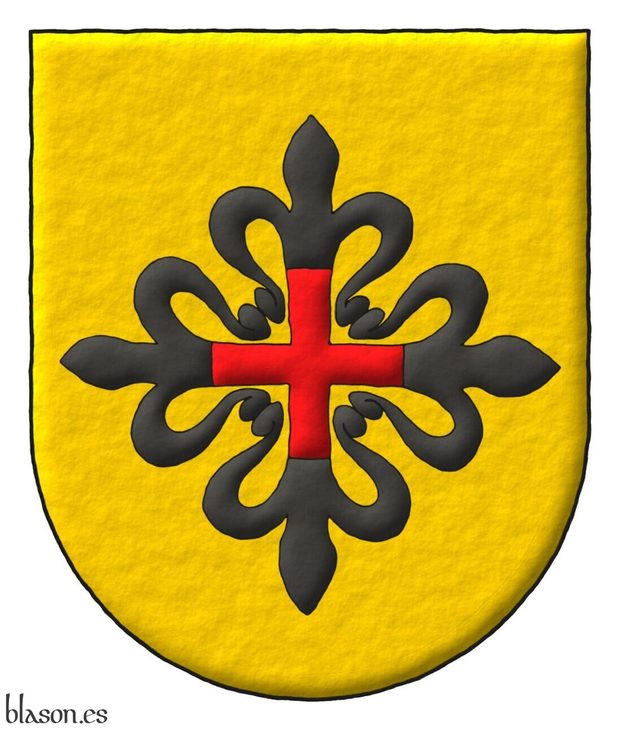
Coat of arms of the Armored Cavalry Regiment Montesa No. 3, RCAC-3, in 2016.
Or, a cross of Montesa.
Escudo de oro, una cruz de Montesa.
Coat of arms interpreted as follows: the shape of the shield is a semi-circular arch; the field has been illuminated in metal Or; the cross of Montesa is outlined in Sable and illuminated in Gules and Sable; and the whole has a raised line finish.
Blazon keywords: Without divisions, Or, Cross of Montesa, Cross couped and Cross.
Style keywords: Semi-circular, Illuminated, Outlined in sable and Freehand.
Classification: Interpreted, Military, Army and Navy and Coat of arms.
Bearer: Montesa, Cavalry Regiment.


Order of Calatrava, emblem
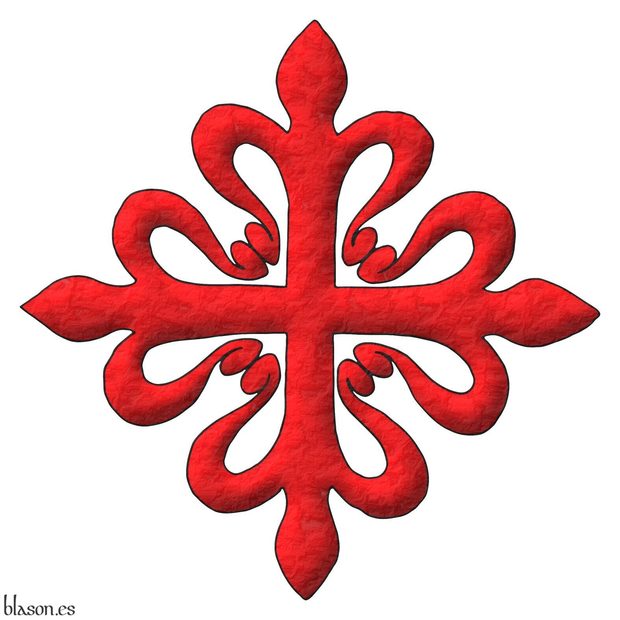
Order of Chivalry of Calatrava
A cross of Calatrava.
Una cruz de Calatrava.
Interpretation of the emblem of the order with: its cross outlined in Sable, illuminated in Gules; and a heavily beaten metal finish.
The Royal Council of the Orders of Chivalry of Santiago, Calatrava, Alcantara, and Montesa, in its historical review of the foundation of the Order of Calatrava, states that it was founded during the reign of Sancho III of Castile in the 12th century.
After the Templars withdrew from the defense of the town, King Sancho III proposed in Toledo and later confirmed in Almazán, in January 1158, the perpetual donation of the town of Calatrava to Raymond, then Abbot of the Cistercian monastery of Fitero, who, together with the former soldier Diego Velázquez, committed to defending it from attacks by the Almohads. For this mission, they received financial support from the Archbishop of Toledo, Juan, and from Toledo itself, thus managing to form an army of more than 20,000 men.
Emblem
Regarding the emblem of the Order of Chivalry of Calatrava [Avilés, J.; 1780b; treatise IV, chapter IV, page 338, figure 102] it states «the Seal was always a red cross with blue straps, and the Banner originally bore a black Cross; but today they use the red cross florety, bordered with eight circles, placed side by side, and joined at the center, formed by a cord that emerges from the leaves of the flower, which Benedict XIII gave (while recognized in Spain) and which is the Commandery that the Knights of this Order wear on their chest today, or hanging from a red ribbon on a gold medal; that is, on a field of Or a cross of Gules».
Blazon keywords: Cross of Calatrava, Cross couped and Cross.
Style keywords: Illuminated, Outlined in sable and Soft metal.
Classification: Interpreted, Religious, Military and Emblem.
Bearer: Calatrava, Order of.


Order of Montesa, emblem
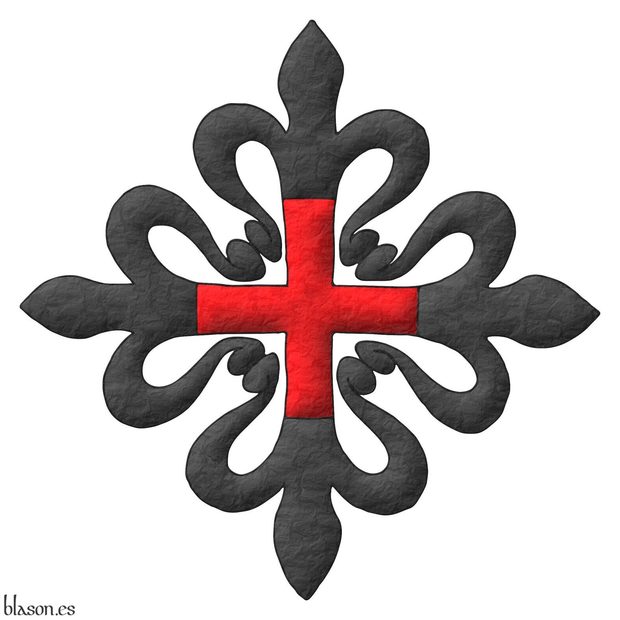
Order of Chivalry of Saint Mary of Montesa and Saint George of Alfama.
A cross of Montesa.
Una cruz de Montesa.
Interpretation of the emblem of the order with: its cross outlined in Sable, illuminated in Gules; and a highly hammered metal finish.
The Royal Council of the Orders of Chivalry of Santiago, Calatrava, Alcantara, and Montesa, in its historical review of the founding of the Order of Montesa, states that it was created in 1317, at the request of James II, King of Aragon, through a bull issued by Pope John XXII.
Emblem
About the emblem of the Order of Chivalry of Montesa [Avilés, J.; 1780b; treatise IV, chapter VI, page 342, figure 103], it states that «the Ensign of the Knights of Montesa is a plain red Cross», gules, «plain, which they wear on their Capitular Mantles, or hanging from a red ribbon on the chest over a gold oval; that is, on a field of gold a plain cross of gules (different from how the Masters wore it)» and, therefore, it describes the first emblem of the Order of Montesa and not the one they wear now, which is that same plain cross of gules charged on a cross like that of the Order of Calatrava or like that of the Order of Alcantara, but in Sable instead of Gules or Vert.
Blazon keywords: Cross of Montesa, Cross couped and Cross.
Style keywords: Illuminated, Outlined in sable and Soft metal.
Classification: Interpreted, Religious, Military and Emblem.
Bearer: Montesa, Order of.


Order of Santiago, emblem
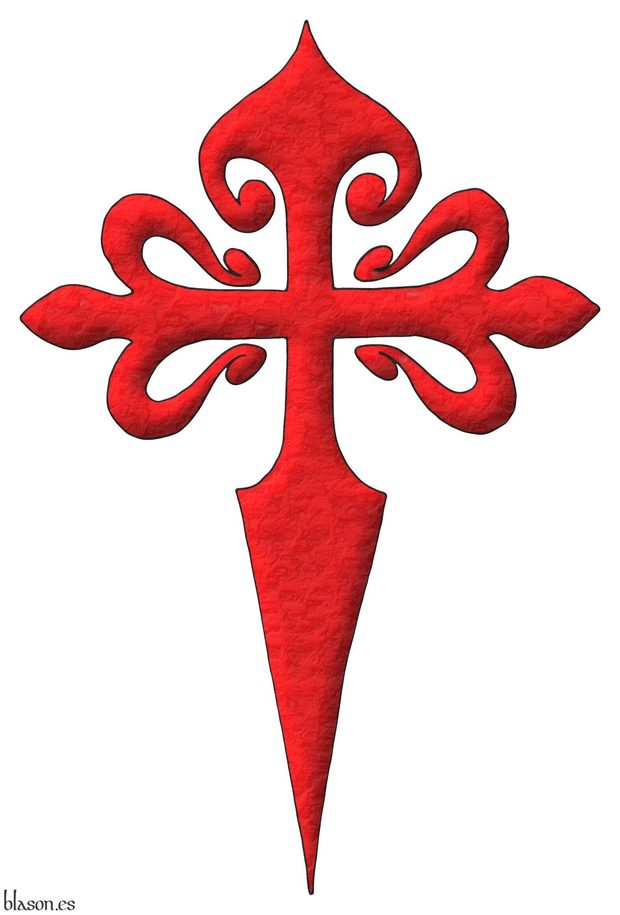
Order of Chivalry of Santiago
A cross of Saint James.
Una cruz de Santiago.
Interpretation of the emblem of the order with: its cross outlined in Sable, illuminated in Gules; and a heavily hammered metal finish.
The Royal Council of the Orders of Chivalry of Santiago, Calatrava, Alcantara, and Montesa, in its historical account of the foundation of the Order of Santiago, describes three different points of view:
- The one presented by tradition, which establishes it in 844, after the battle of Clavijo, when fourteen knights led by the Field Master Don Sancho Martínez de Tejada requested permission from Don Ramiro I, king of Asturias between the years 842 and 850, to found it. This traditional view is the one recorded in [Avilés, J.; 1780b; treatise IV, chapter II, page 325] when discussing the origin of the «Military Order of Santiago of the Sword».
- The perspective of historians like Claudio Sánchez Albornoz or Américo Castro, who question the earlier date. Furthermore, [Sánchez Albornoz, C.; 1965; pages 94-136], as cited in [Domínguez García, J.; 2008; pages 69-70], proposes that the actual battle of Clavijo occurred later, in the year 859, and that Ramiro I did not participate, but rather it was a conflict between King Ordoño I and the Moor Muza.
- The view of historians who, based on the statutes of the order found in the Monastery of Uclés, which was the residence of the Master of the Order of Santiago, and the Latin in which they are written, believe that the foundation could indeed date back to the reign of Don Ramiro I.
Emblem
Regarding the emblem of the Order of Chivalry of Santiago, [Avilés, J.; 1780b; treatise IV, chapter II, page 328, plate 25, figure 100] states «the Commandery of this Order was always a red Sword» (gules ~ red), «in the form of a Cross, just as the guards of the ancient Swords that its Knights and Commanders carried on their white Mantles, and today also on the chest in the same manner, hanging from a red ribbon on a gold medal; that is, in a field of Or, a Cross of Gules».
Blazon keywords: Cross of Saint James, Cross couped and Cross.
Style keywords: Illuminated, Outlined in sable and Soft metal.
Classification: Interpreted, Religious, Military and Emblem.
Bearer: Santiago, Order of.


Richard de Bures outlined
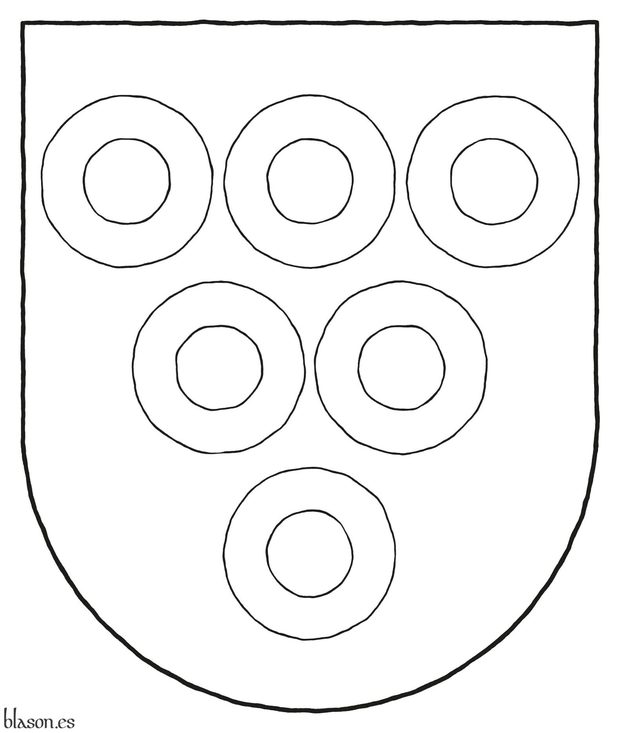
Or, six annulets Gules, 3, 2, and 1.
Escudo de oro, seis anilletes de gules, ordenados 3, 2 y 1.
Blazon keywords: Or, Six, Annulet, Gules, Ordered, Three, Two and One.
Style keywords: Outlined in sable and Semi-circular.
Classification: Religious, Military, Knights Templar, Interpreted and Coat of arms.
Bearer: Richard, Richard.


Robert de Craon
Lozengy Or and Gules. Behind the shield a cross patty Gules.
Blazon keywords: Lozengy, Or, Gules, Behind the shield, One, Cross patty and Cross couped.
Style keywords: Outlined in sable, Illuminated, Semi-circular and Freehand.
Classification: Religious, Military, Knights Templar, Interpreted and Coat of arms.
Bearer: Craon, Robert de.


Tercio Alessandro Farnese, plain tincture
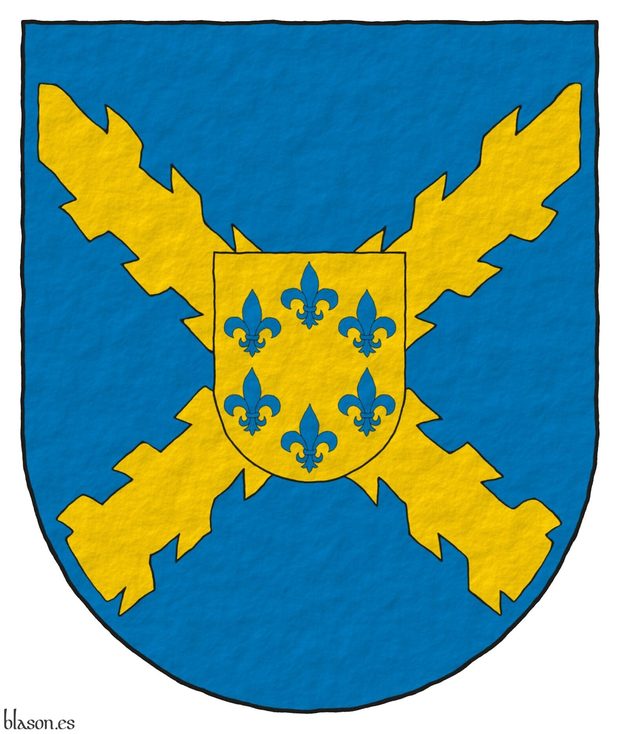
Azure, a cross of Burgundy Or; an inescutcheon Or, six fleurs de lis in orle Azure.
Coat of arms depicted by me, in plain tinctures, outlined in Sable, with a semi-circular external shape and with a texturized finishing.
Coat of arms of the Tercio Alessandro Farnese, 4th of the Spanish Legion, emblazoned by me. In 1956, the fourth Tercio of the Spanish Legion was created and named Tercio Alessandro Farnese in his honor. The inescutcheon has in orle the 6 fleurs the lis of the Farnese family.
Blazon keywords: Azure, Or, One, Six, Cross of Burgundy, Cross couped, Inescutcheon, Fleur de lis and In orle.
Style keywords: Outlined in sable, Plain tincture and Semi-circular.
Classification: Military, Interpreted, Boa and Coat of arms.
Bearer: Tercio Alessandro Farnese.


Tercio Great Captain, plain tincture
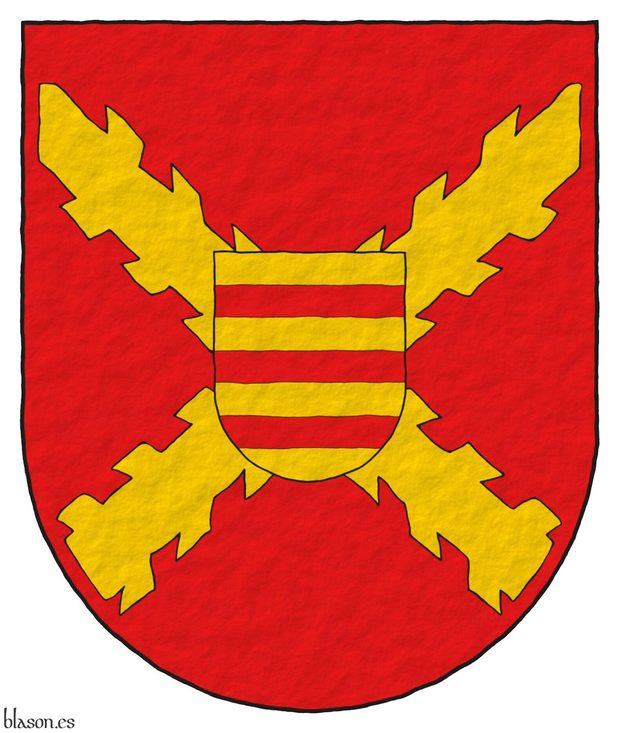
Gules, a cross of Burgundy Or; an inescutcheon Or, three bars Gules.
Arms interpreted by me, in plain tinctures, outlined in Sable, with a semi-circular outer contour and with a texturized finish.
Coat of arms of the Tercio Great Captain, 1st of the Spanish Legion, emblazoned by me. The inescutcheon represents the coat of arms of Gonzalo Fernandez de Cordoba, 1453-1515, known as «The Great Captain». It was Gonzalo Fernandez de Cordoba who reorganized the Spanish infantry, laying the foundations for what would later become the Tercios.
Blazon keywords: Gules, Or, One, Three, Cross of Burgundy, Cross couped, Inescutcheon, Bar and Fess.
Style keywords: Outlined in sable, Plain tincture and Semi-circular.
Classification: Military, Interpreted, Boa and Coat of arms.
Bearer: Tercio Great Captain.


The coat of arms of Jacques de Molay in 3 steps
Azure, a bend Or.
Blazon keywords: Azure, One, Bend and Or.
Style keywords: Outlined in sable, Illuminated, Semi-circular, Plain tincture and Freehand.
Classification: Religious, Military, Knights Templar, Interpreted, Coat of arms and Schema.
Bearer: Molay, Jacques de.


The coat of arms of Renaud de Vichiers in 3 steps
Vair.
Blazon keywords: Vair.
Style keywords: Outlined in sable, Illuminated, Semi-circular, Plain tincture and Freehand.
Classification: Religious, Military, Knights Templar, Interpreted, Coat of arms and Schema.
Bearer: Vichiers, Renaud de.
-
Language
-
Categories of heraldry
-
Divisions of the field
- Without divisions
- Party per pale
- Party per fess
- Party per bend
- Party per bend sinister
- Tierce
- Tierce sinister
- Tierced per pale
- Tierced per fess
- Tierced per bend
- Tierced pallwise inverted
- Quarterly
- Quarterly per saltire
- Gyronny
- Party per fess, the chief per pale
- Party per pale, the sinister per fess
- Party per fess, the base per pale
- Party per pale, the dexter per fess
- Chapé
- Chaussé
- Embrassé
- Contre-embrassé
- Party per chevron
- Enté
- Enté en point
- Flanched
-
Metals
-
Colours
-
Furs
-
Other tinctures
-
Ordinaries and sub-ordinaries
-
Diminutives of the ordinaries
-
Geometric charges
-
Composite ordinaries
-
Inanimate charges from Nature
Atom, Crescent, Diamond, Emerald, Estoile, Increscent, Lightning flash, Moon, Mount, Mullet, Mullet of four points, Orbital, Plough of Ursa Major, Rainbow, Ray of the sun, River, Sea, Snowflake, Sun, Sun in splendour, Sun of May, Trimount, Water and Wave.
-
Vegetal charges from Nature
Acorn, Apple, Apple tree, Ash, Bluebonnet, Camellia, Chrysanthemum, Cinquefoil, Cornflower, Dogwood flower, Double rose, Elm, Fleur de lis, Flower, Gourd, Holm oak, Hop cone, Indian paintbrush, Kapok tree, Laurel, Lily, Linden, Lotus flower, Madonna lily, Mexican cedar tree, Oak, Olive tree, Palm tree, Plantain plant, Pomegranate, Poplar leaf, Rose, Shamrock, Sunflower, Thistle, Tree, Tulip, Vine and Wheat.
-
Animal charges from Nature
Badger, Bald eagle, Barbel, Barn owl, Bear, Beaver, Bee, Beetle, Bighorn sheep, Binson, Blackbird, Boar, Brach hound, Bull, Doe, Dog, Dolphin, Dove, Eagle, Elephant, Falcon, Female figure, Fish, Flame, Fly, Fox, Frog, Goat, Goldfinch, Goose, Heron, Horse, Hummingbird, Jaguar, Lark, Leopard, Lion, Lion passant, Lion rampant guardant, Lioness, Lynx, Male figure, Martlet, Merino ram, Owl, Panther, Parrot, Peacock, Pelican, Pelican in her piety, Pronghorn, Puffin, Quetzal, Raven, Roe deer, Rooster, Savage, Seagull, Serpent, She-wolf, Stag, Starling, Talbot, Tyger, Vulture, Warren hound and Wolf.
-
Parts of natural charges
Arm, Beak, Branch, Caboshed, Chest, Claw, Covert, Dorsal fin, Eagle claw, Ermine spot, Escallop, Feather, Foot (palmiped), Foreleg, Forepaw, Hand, Head, Heart, Hoof, Leaf, Neck, Ostrich feather, Palm frond, Paw, Roe deers' attires, Shoulder, Sprig, Stags' attires, Stem, Swallow-tail, Tail, Tail addorsed, Tail fin, Talon, Tibia, Tooth, Trunk, Trunk (elephant), Two hands clasped, Two wings in vol, Udder, Wheat spike, Wing and Wrist.
-
Artificial charges
Ace of spades, Anchor, Anvil, Arch, Arm vambraced, Armillary sphere, Arrow, Axe, Bell, Bell tower, Beret, Bonfire, Book, Bookmark, Bow, Branding iron, Bridge, Broken, Buckle, Cannon, Cannon dismounted, Cannon port, Canopy roof, Carbuncle, Castle, Celtic Trinity knot, Chain, Chess rooks, Church, Clarion, Clay pot, Closed book, Club, Column, Comb, Compass rose, Conductor's baton, Cord, Covered cup, Crozier, Crucible, Cuffed, Cup, Cyclamor, Dagger, Double vajra, Drum, Ecclesiastical cap, Fanon, Federschwert, Fleam, Four crescents joined millsailwise, Galician granary, Garb, Gauntlet, Geometric solid, Grenade, Halberd, Hammer, Harp, Host, Hourglass, Key, Key ward, Knight, Knot, Lantern, Letter, Line, Loincloth, Menorah, Millrind, Millstone, Millwheel, Monstrance, Mortar, Mullet of six points pierced, Nail, Non-classic artifact, Norman ship, Number, Oar, Oil lamp, Open book, Page, Pair of scales, Parchment, Pestle, Piano, Pilgrim's staff, Plough share, Polish winged hussar, Port, Portcullis, Potent, Quill, Ribbon, Rosette of acanthus leaves, Sabre, Sackbut, Sail, Scroll, Scythe, Sheaf of tobacco, Ship, Skirt, Spear, Spear's head, Stairway, Star of David, Step, Sword, Symbol, Tetrahedron, Torch, Tower, Trident, Trumpet, Turret, Two-handed sword, Wagon-wheel, Water-bouget, Wheel, Winnowing fan and With a turret.
-
Immaterial charges
Angel, Archangel, Basilisk, Dragon, Dragon's head, Garuda, Golden fleece, Griffin, Heart enflamed, Justice, Mermaid, Our Lady of Mercy, Ouroboros, Paschal lamb, Pegasus, Phoenix, Sacred Heart of Jesus, Saint George, Sea-griffin, Trinity, Triton, Unicorn, Winged hand and Wyvern.
-
External elements
-
Heraldic creations
-
References
-
Formats
-
Keywords on this page
Port and windows, Behind the shield, Alcantara, Cavalry Regiment, Alcantara, Order of, Iridescent (nacar), Annulet, Pointed, Article, Azure, Boa, Castle, Crowned, Cross, Cross of Alcantara, Cross of Burgundy, Cross of Montesa, Cross couped, Outlined in sable, Doctor, Army and Navy, Emblem, Black and white and color illustrations, Coat of arms, Inescutcheon, Schema, Fleur de lis, Gules, Illuminated, Interpreted, Castilian language, Lion, Masoned, Semi-circular, Metal beaten, Soft metal, Military, Knights Templar, Or, Party per pale, Argent, Without divisions, Rampant, Religious, Sable, Six, Plain tincture, Freehand, Three and One.

